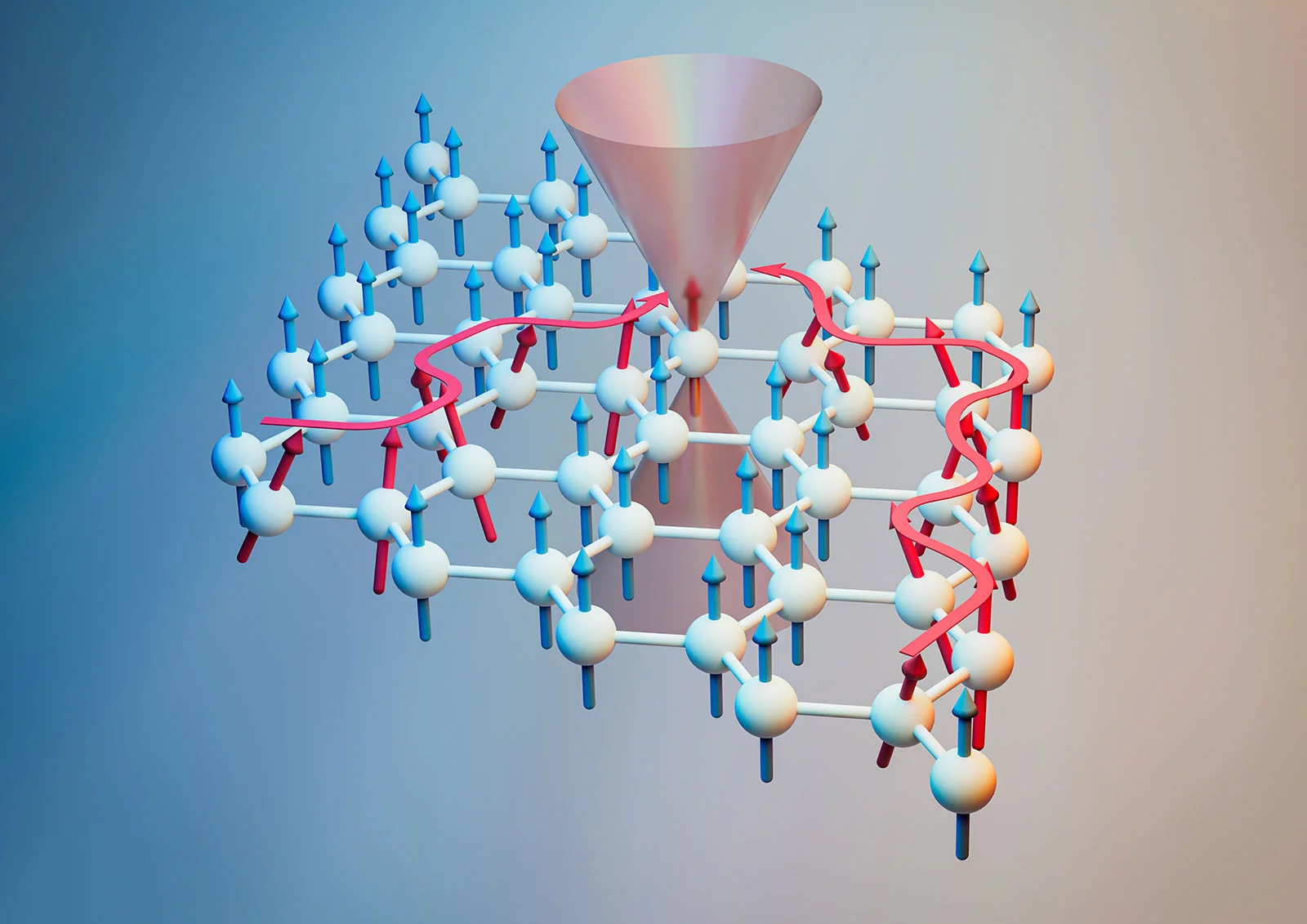Graphene owes most its hailed physical properties to its honeycomb lattice structure. Now, researchers at Paul Scherrer Institute PSI have investigated its magnetic equivalent: chromium tribromide. This material, which possesses identical lattice geometry to graphene, is still magnetic when slimmed down to a single atomic layer. Using advanced neutron scattering, the researchers probed the magnetic band structures in a crystal of the material at unrivalled resolution. The complex magnetic topology that they revealed extends our fundamental understanding of magnetism, which may lead to exciting technological applications. Their findings are published in the journal Physical Review Letters.
Shave off a single layer of graphite, one atom thick, and you have graphene: the wonder material of the twenty first century. Its discovery in 2004 founded the field of atomically thin materials, whereby the behaviour of electrons in a two-dimensional plane gives rise to exotic topological quantum effects. Under the microscope, graphene’s carbon atoms form a honeycomb pattern of hexagons. It is this structure that can be thanked for so many of graphene’s astonishing physical properties.
Now, researchers from PSI have given new insights into a magnetic equivalent of graphene. In the material chromium tribromide, magnetic ions lie in the same honeycomb geometry as on the graphene lattice. Known as a two-dimensional ferromagnet, chromium tribromide can retain its magnetism when exfoliated to a single layer of atoms, unlike many traditional ferromagnets.
Although chromium tribromide has been known for some time, today’s knowledge of – and lust for - graphene puts it in an entirely different perspective. Using advanced neutron scattering at the Swiss Spallation Neutron Source SINQ and at Institut Laue-Langevin in France, the researchers mapped the material’s magnetic excitations to unprecedented resolution revealing magnetic analogies of the spectacular topological features found in graphene.
“50 years ago, when people investigated chromium tribromide’s magnetism, no one knew about graphene. So they didn’t look to see if the interesting magnetic topology was there,” says Stanislav Nikitin, research scientist at PSI and first author of the recent publication.
Magnon band structure
All magnetic materials possess collective excitations of the magnetic moments of electrons in the crystal lattice. In a magnetically ordered material these, like little compass needles, all point the same way. Yet if one magnetic moment is deflected from its equilibrium position, it causes its neighbour to do the same, and in this way a spin wave – known as a magnon – can pass through the material.
Many of graphene’s physical properties are the result of its electronic band structure – the energy levels that electrons may occupy. These bands can weave and twist, in a topology that is dictated by the lattice geometry. In the same way, magnons in chromium tribromide form a magnetic band structure. The topology of magnon band structures has become a matter of active theoretical and experimental research due to possible applications for encoding protected information in spintronics and skyrmionics.
Dirac cones: the honeycomb hallmark
The researchers could reveal that the magnon band structure of chromium tribromide displays a hallmark of graphene’s electronic band structure: a feature known as Dirac cones. These arise because of symmetry properties in the honeycomb lattice structure, which mean that at certain points the valence and conduction bands meet. Around these points, the bands form cone shapes, causing the electrons (in graphene) to behave as if they are massless and resulting in curious quantum effects.
Yet, as Andreas Läuchli explains, predicting the physical properties these will give rise to in chromium tribromide is not straightforward. “Dirac cones in Graphene’s electronic topology are responsible for many of its interesting electronic properties. But a magnon is not an electron, so the results will not be the same in chromium tribromide as in graphene – it will be exciting to find out what these will be.” Läuchli’s research group developed theoretical descriptions of the magnon band structure in chromium tribromide.
Magnons feel the heat
To get a better understanding of how the magnons behave around Dirac cones, the researchers probed how the magnons changed whilst they forced them to interact with each other. To do this, they heated them up: from less than 2 Kelvin, up to 40 Kelvin. Magnon interactions are important as they affect the magnon lifetime - an essential quality for their future use to transfer information.
Adding thermal fluctuations to the intricate quantum fluctuations led to magnetic effects so complex that they could not be explained with current theoretical models. “This is quite an important finding, because it shows that the real-life material is way more complex than our current theoretical understanding,” explains Nikitin. Here, it is not just the band gaps that are exciting, but also the theory gaps.
Text: Paul Scherrer Institute / Miriam Arrell
Contact
Dr. Stanislav Nikitin,
Postdoctoral researcher
Quantum Criticality and Dynamics Group
Paul Scherrer Institute, Forschungsstrasse 111, 5232 Villigen PSI, Switzerland
Telephone: +41 56 310 30 06, email: stanislav.nikitin@psi.ch
Prof. Dr. Andreas Lauchli,
Head of the Laboratory for Theoretical and Computational Physics (LTC)
Group leader of the Computational Physics Group
Paul Scherrer Institute, Forschungsstrasse 111, 5232 Villigen PSI, Switzerland
Telephone: +41 56 310 42 60, email: andreas.laeuchli@psi.ch
Original Publication
Thermal Evolution of Dirac Magnons in the Honeycomb Ferromagnet CrBr3
S. E. Nikitin, B. Fåk, K. W. Krämer, T. Fennell, B. Normand, A. M. Läuchli, and Ch. Rüegg
Physical Review Letters, 13 September 2022
DOI: 10.1103/PhysRevLett.129.127201
Copyright
PSI provides image and/or video material free of charge for media coverage of the content of the above text. Use of this material for other purposes is not permitted. This also includes the transfer of the image and video material into databases as well as sale by third parties.

